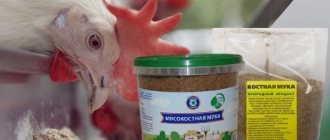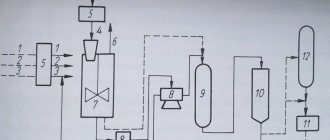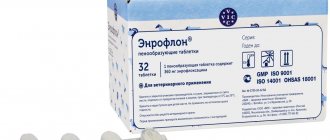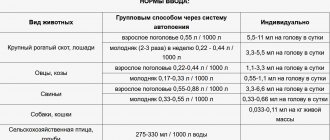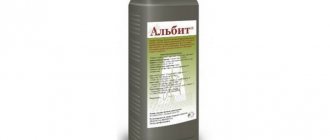Therapy with antibiotics is indispensable for some ailments of birds, but it is fraught for those who become consumers of products obtained from chickens that were given these drugs. Frequent use of broad-spectrum antibiotics contributes to the accumulation of toxic substances in the body, which, entering the human body with products, cause resistance to this group of drugs and complicate the overcoming of human disease.
Therefore, in private households, antibiotics are used only in emergency situations. After treatment, you can eat meat and eggs only after 28 days, and after preventive measures - after a week.
Oflosan
Belongs to the fluoroquinolone family, a drug with antibacterial and antimycoplasma action. The highest concentrations are observed in the lungs, liver and kidneys. Peak concentration in the blood occurs after 90-120 minutes.
Oflosan is prescribed for hens and chickens with colibacillosis, salmonellosis, necrotic enteritis, arthritis, laryngotracheitis. If necessary, give from the first day. Contraindicated in laying hens and young animals 14 days before laying, as it accumulates in the eggs in a dose that can harm the consumer. They cannot treat individuals whose nervous system is weakened.
The simultaneous use of chloramphenicol, tetracycline, cyclosporine is prohibited. Oflosan is mixed with drinking water and administered orally. Depending on the causative agent of the disease, the proportion is chosen. In the acute form of uncomplicated diseases, give 50 ml with 100 liters of water once a day for 3-5 days. If you need to treat salmonellosis, mixed infections or a chronic form, then dilute 100 ml of ofloxacin in 100 liters of water. You need to take this medicine for 5 days.
To achieve the desired result, all drinking bowls must be either filled with the drug solution or empty. It is important to adhere to the same time of administration of the antibiotic. Side effects that can be observed in case of overdose: loss of appetite, impaired coordination of movements, drowsiness, vomiting. For preventive purposes, the proportion is changed to 1:3.
What to give to laying hens and broilers
Depending on the measure of use (therapy or prophylaxis), antibiotics are used for broilers and laying hens with varying degrees of exposure and dosage.
Broilers are sensitive to environmental factors and do not regulate their body temperature well, so they can be susceptible to hypothermia. To avoid the development of pathologies, antibiotics for chickens and grown-up individuals are mandatory. These are mainly Trichopolum and Furazolidone.
Chickens that lay eggs are also exposed to various infections that can affect productivity or lead to death. But due to the fact that antibiotics accumulate in the body, it is necessary to select drugs that are quickly eliminated from the tissues and blood of birds. For example, Biomycin, Sulfadimezin or Tromexin.
Levomycetin
Belongs to amphenicols. Levomycetin is used for internal use in the form of a white or yellowish tablet. Shelf life is limited to 5 years when stored in a cool place away from light. Effectively destroys many strains of bacteria that are resistant to penicillin, tetracycline, sulfonamide and their derivatives.
With its help you can cure genitourinary infections, bronchopneumonia, gastroenteritis, salmonellosis, colibacillosis, meningitis. The tablet is crushed and 30 mg is dissolved in 1 liter of water. The course of admission is up to 7 days, no more. When symptoms disappear, stop taking. For pasteurellosis, they are given along with fish oil (300 mg - chloramphenicol, 100 g - fish oil) in the feed at 30 mg per kilogram of bird weight. For coccidiosis in chickens, the dose is adjusted to 10 mg/kg and given for 4 days, and after a three-day break the course is repeated. For laryngotracheitis, it is mixed into water.
Side effects may include vomiting, diarrhea, skin rash, bloating, dermatitis, and inflammation of the pharynx. Levomycetin has a high absorption rate, so it is given prophylactically only for 2-4 days.
Preparations for laying hens
There are quite a few medications that can be used to treat laying hens.
Biomycin
The drug is released in the form of a white powder. It is recommended to mix it with water before use. The drug should be administered intramuscularly or orally. Most often, the composition is used not for preventive purposes, but for the development of young birds. The use of Biomycin helps accelerate the growth of birds by 25%.
Sulfadimezin first
This product copes with most bacterial microorganisms. It is not as effective as antibiotics, but has less toxic properties. The product can be used to treat most bacterial infections.
This is interesting: Description of the best varieties (seeds) of dill for growing herbs in open ground
With its help, it is possible to cope with coccidiosis, salmonellosis, and respiratory diseases. The composition is actively used for sore throat, laryngitis, and pneumonia. To achieve good results, the drug is simultaneously administered intramuscularly and orally.
Chlortetracycline
This medicine belongs to the tetracycline category. It is produced in the form of a yellow powder. The composition is used to enhance the development of females. It is used for the treatment and prevention of diseases such as coccidiosis, pneumonia, mycoplasmosis. The composition is administered intramuscularly or orally.
Tromexin
This product has a wide spectrum of action. It helps to cope with pathologies of the intestines and respiratory organs. The composition is actively used for diarrhea. It is acceptable to use the product with dry food or make a solution from it.
Sulfadimezin
The advantage of the product is considered to be low toxicity. The drug is easily absorbed and has minimal side effects. The medicine is released in the form of a white-yellow powder. It is used to fight typhoid and salmonellosis. The medicine also copes with diseases of the respiratory system and coccidiosis.
Fluoroquinolones
Fluoroquinolones are antibacterial drugs that have a special chemical structure and origin. Veterinarians recommend that poultry farmers use them orally. They use enroxil, baytril, oflosan, floxacin, enrofloxacin, etc., which are liquids to be diluted in water for 5-6 days.
Furazolidone is given to chickens for coccidiosis, typhus and pullorosis of chickens. The dose is divided into 3 doses with an interval of 4-6 hours. For pullorosis, 5-7 g per 1000 individuals are prescribed, for typhus - 3-4 g per 1000. Yellow fine-crystalline powder is mixed into the feed. Resistance to it develops very slowly, so it is often used in the fight against microorganisms that are resistant to sulfonamides and antibiotics.
What antibiotics should be given to chickens for treatment?
Sick chicken
In the EEC countries, a legislative ban has been introduced on the use of feed antibiotics. They were replaced with probiotics. Such a system requires strict implementation of poultry rearing technology, and the slightest failure results in a large-scale death of chickens. Therefore, in domestic poultry farming there is no alternative to feed antibiotics when raising chickens.
Antibiotics based on Tylosin
Treatment is carried out with drugs based on Tylosin. Tilan, tilanik are dissolved in water and given with feed. Tilan 250 premix is intended for preventive measures against mycoplasmosis. Causative agents of respiratory diseases are sensitive to them.
Complex medications that include Tylosin are widely used:
- Biofarm-120 is a compound of Biomycin and Farmazin, which is added to food because it does not dissolve in water. Effectively fights against mycoplasma and related contagions. Meat can be collected after 5 days from the last use.
- Eriprim is expanded with colistin, trimethoprim and sulfadimidine. Prescribed for diseases of the respiratory tract and gastrointestinal tract of contagious origin. Combine with food or water. The bird will be ready for slaughter for meat only after 10 days.
Contents of a first aid kit when raising chickens
It is quite common that every person has a first aid kit in his home - medications that may be needed to provide first aid when a life-threatening situation, or to treat simple ailments. The same applies to poultry, including laying hens. Here is a recommended list of medications that should be present to treat broilers:
- Peroxide in liquid form
- Activated carbon or any other enterosorbent
- Regular soda
- Zelenka, iodine
- Castor oil
- Set of pipettes
- Syringes for injections and for measuring drug doses
- Cotton wool and bandages
- Antibiotics
As you can see, the list also includes antibiotics, since the treatment of many diseases, alas, cannot be done without their use.
The most commonly used antibiotic for poultry, including broiler chickens, is Baystril. The active ingredient that fights the pathogen, enrofloxacin, has a wide spectrum of action, is well absorbed and begins to act quickly. It is used to treat such terrible diseases as:
- Salmonellosis
- Colibacillosis
- Enteritis
- Hepatitis and many other diseases caused by microbes
The second most commonly prescribed antibiotic for chickens is Enroflon. Unlike the previous drug, which is most often produced in the form of a solution for intramuscular administration, Enroflon is produced in the form of a concentrated liquid that must be diluted with drinking water, that is, soldered. If we list the diseases that this antibiotic successfully fights, they will look identical to those in the previous description.
Enroxil is an antibiotic that also acts on the basis of enrofloxacin. It is most often prescribed when the gastrointestinal tract of chickens is affected, and it is necessary to make sure that the causative agent of the disease will respond to the administration of enroflosacin, that is, it will be sensitive to it. As you know, this can only be verified through laboratory research, that is, by submitting the bird’s biomaterial for analysis.
Amoxicillin is a broad-spectrum antibiotic designed to fight diseases affecting the gastrointestinal tract, respiratory tract, and urinary system.
If parasites are found in a chicken, then you need to start a course of antiparasitic drugs. For this, medications such as the previously described Baycox, as well as Solicox, are suitable. Both medications are generally classified as coccidiostatics. However, it is Solikoks that most successfully fights parasites. The most well-known and common disease caused by parasites is coccidiosis.
Veterinarians prescribe Solicox in every 3rd case, so it makes sense to keep this medicine in your poultry medicine cabinet. It is also worth noting that Solikoks is recognized as one of the most low-toxic veterinary drugs, that is, it has virtually no effect on the psychosomatic state of the chicken and has no side effects.
If you find it difficult to decide what the composition of your first aid kit for poultry should be, then you can buy a ready-made set of veterinary supplies; this option is now available in many veterinary pharmacies; you can also make such a purchase on the Internet. If you believe the reviews of poultry farmers, then such “wholesale purchase” is more profitable than buying medicines separately.
Tetracyclines
Tetracycline is a broad-spectrum antibiotic. They treat bronchopneumonia, dysentery, gastroenteritis, pasteurellosis, salmonellosis, colibacillosis, laryngotracheitis, and respiratory mycoplasmosis of chickens.
A common drug in this series is biomycin. It is dissolved in water and given to drink for a week with a dosage of tetracycline for chickens of 5-10 mg per kilogram of weight. Efficiency is manifested against bacteria and some viruses, which is explained by the suppression of protein synthesis. It is administered once a day to achieve maximum concentration, since this drug is excreted over 22-24 hours through the kidneys, bile and gastrointestinal tract.
In private farmsteads, biovit is often used, which has a growth-stimulating effect, a high concentration of B vitamins and from 4 to 12% microbial protein. Use 63 mg per kilogram for chickens for 7 days. It also helps to increase egg production, but is excreted from the body only after 5 days.
Tips for detoxing birds from drugs
Antibiotics are eliminated from the body of chickens naturally. But in case of imminent slaughter or collection of eggs, it is desirable that the medicine comes out as soon as possible. There are some effective tips.
To restore the microflora of the poultry’s gastrointestinal tract, probiotics are added to the food, and fermented milk is also given: cottage cheese, yogurt, fermented baked milk.
The chickens’ diet is also enriched with fresh herbs, fruits and vegetables.
There should always be clean liquid in the drinking bowls.
The birds are given outdoor exercise.
Often, antibiotics are rarely added to the diet of chickens raised on a private farm. Unlike the menu of birds kept in poultry farms.
Sulfonamides
Antibiotics for chickens of this group are active in the fight against streptococcus, pneumococcus, enterococcus, staphylococcus, E. coli, protozoa and large viruses. They have a bacteriostatic effect. They deprive microbes of para-aminobenzoic acid, without which they do not divide or multiply, and become defenseless against the forces of the immune system.
They are part of the antimicrobial complexes: eriprim, tromexine, zinaprim. When used, they have a peculiarity in dosage: in the first days, a loading dose is required, which is twice the therapeutic dose. Broiler chickens and young animals are given 3-4 days, starting with a dose of 1 g per cubic decimeter.
Features of antibiotics for chickens
Birds should be given antibiotics starting from a young age. This significantly reduces the risk of contracting viral diseases. Many adult chickens suffer from chronic coccidiosis or histomoniasis. And if this practically does not harm them, then the young animals may die in the event of an acute form of these diseases. Therefore, the use of antibiotics for chickens in the first days of life is necessary for growth and development.
Suitable for this:
- penicillin;
- tetracycline;
- chloramphenicol;
- tylosin;
- tromexine.
Antimicrobial drugs remain in the body of a sick bird for a long time. The remaining medication may come out a month after taking it. This significantly deteriorates the quality of eggs, so it is not recommended to eat laying hen products during antibiotic therapy.
To prevent such situations from arising, it is worth worrying about prophylactic feeding of antiviral drugs from the first days of life of chickens. If everything is done correctly, as described above, the bird population will be healthy, and the meat and eggs will be tasty!
Trichopolum
The active substance, metronidazole, is not an antibiotic, but an antiprotozoal drug that interacts with the shell of the microorganism and disrupts acid metabolism, thereby killing the bacterium. It does not cause intestinal dysfunction, but requires caution in use.
As a prophylactic measure, the drug is mixed with dry feed for broilers at a dose of 20-25 mg/kg body weight for 5 days and this is done every 14 days until the chicks are one and a half months old. Prescribed for treatment of coccidiosis and histomoniasis. A drug solution for oral use is recommended. Chickens with coccidiosis are diluted with 0.1 g per kilogram of weight in warm water and fed with a syringe for 10 days three times a day. For histomoniasis - 0.25 g/kg - 10 days, trichomoniasis - 25-50 mg/kg - 2 days, repeated after seven days.
To stop drainage from the eyes or nose, they must be washed with a 0.1% trichopolum solution. Dyspepsia or gastrointestinal disorders are also treated with this drug - 20 mg/kg, dissolved in water.
Furazolidone
Belongs to nitrofuran drugs of the antibiotic group. The active substance kills microorganisms, creates and maintains non-pathogenic microflora. Effective not only against bacteria, but also against viruses.
Used for chickens after 10 days and adults. The dose is adjusted taking into account the disease and weight of the bird. Prophylactically give 3 g per kilogram of weight in food or water for 3 days. At the beginning of egg laying, young animals are given 5 g per 1000 heads for 5 days monthly.
When treating coccidiosis, mycoplasmosis, streptococcosis, 2 mg of furazolidone per patient is mixed into food for up to a month, after which it is necessary to increase the amount to 3 mg. The required course is 3-9 days. If affected by parasites or viral-bacterial infections, therapy is carried out at 3 mg/kg for 5-7 days. You can repeat the course after 10 days.
The role of antibiotics in the life of laying hens
Photo
By nature, chicken is a vulnerable animal. She can become infected both from the external environment and from other members of the pack.
Most diseases, if not treated promptly, lead to death. The only way out of the situation is to take appropriate measures in time.
Antibiotics for chickens are special preparations whose action is aimed at destroying infections and other foci of diseases in the body of the bird. Veterinarians have developed a whole range of products that have both a wide and narrow spectrum of action.
It is believed that it can almost always be dealt with using traditional methods. But there are diseases that chickens cannot tolerate without antibiotics.
It is very important that every owner can identify the disease in a timely manner and know how to cure it. Inaction can lead to complete loss of the farm.
Veterinarians divide the entire range of ailments into two groups:
- infectious;
- invasive.
The first occur in laying hens due to the entry of a pathogenic virus into the body. These are certain microorganisms that negatively affect health and are easily transmitted from one individual to another. Antibiotics are prescribed for infectious diseases such as:
- pullorosis;
- coccidiosis;
- pasteurellosis;
- salmonellosis;
- infectious bronchitis;
- chicken flu;
- chicken pox;
- colibacillosis;
- mycoplasmosis;
- Newcastle disease;
- neurolymphomatosis;
- laryngotracheitis.
Invasive diseases are characterized by external manifestations. The causative agents are various parasites that live on the chicken’s body and, in addition to causing discomfort, affect its egg production and general condition. Treatment with antibiotics is usually not carried out. It is possible to use special sprays and drops for external use.
Baytril
One of the fluoroquinoline preparations is enrofloxacin, which can be found on the market in the form of injections, oral liquid or for mixing into food. Baytril, like all fluoroquinolines, stops the proliferation of bacteria, so it can easily cope with even very extensive foci of inflammation. For prevention, 1 ml is diluted with water (2 l) and given from 2-4 days, and from the 5th day - vitamin complexes.
To cure diseases, the dose of the drug is increased according to the scheme: 1 day - 50 ml/100 l of water 1 time per day, 2 - 100 ml/100 l 2 times, 3 - 200 ml/100 l with an interval of 6 hours, 4 - 400 ml/100 l after 3 hours . After 4 days the scheme is repeated from the beginning. Indicated for the treatment of salmonellosis, diarrhea, mixed infections. Cannot be used with chloramphenicol, macrolides, tetracyclines and the like.
What else do you need to know?
After treatment or prophylaxis with antibiotics, the bird needs to cleanse the body of the accumulated drug.
There are several ways to speed up this process:
- Drink plenty of fluids – there should always be fresh, clean water in the sippy cup.
- Restoration of intestinal microflora - birds are given special preparations, and fermented milk products (cottage cheese, fermented baked milk, kefir) are introduced into the diet of young animals.
- Fresh air and plant food - during the warm period, birds should be outside as long as possible. This way they can eat green grass, which is a source of vitamins.
- If the treatment took place in the autumn-winter period, instead of grass, give fresh vegetables - carrots and white cabbage.
- Introduction to the diet of mineral-vitamin complexes and protein foods - inert and meat-and-bone meal.
Dietrim
A complex drug combining sulfadimezin and trimethoprim is used in solution. It is classified as a low-toxic but dangerous (class 4) substance. Active in the fight against gram-positive and gram-negative bacteria. It takes a long time to be removed from the body: 22-24 hours. The maximum concentration is after 2-3 hours.
Treatment is carried out according to a single scheme: 1 ml/1 liter of water, which is given to the wards to drink for 2-5 days, in case of acute illness - twice with the same dosage after the same period of time. The course should not exceed 7-8 days.
Features of application
Antibiotics are used to suppress the activity of pathogenic bacteria. They often have to be used to treat chickens, since they do not tolerate infection with infectious pathologies.
This is interesting: Which magnolia to plant in the garden
To choose the right medicine, you should consider the following features:
- poultry weight – a smaller dosage is used for treating chickens;
- origin - the medicine must have a tendency to accumulate and at the same time completely leave the body;
- the condition of the chicken - means of varying degrees of effectiveness are used for therapy and prevention.
Enroflon
The basis of this drug is enrofloxacin. But it is able to defeat many bacteria: Pseudomonas aeruginosa, streptococcus, mycoplasma, staphylococcus and pathogenic fungi. Indicated for mycoplasmosis, salmonellosis, colibacillosis, viral bronchopneumonia.
Prophylactic dose - 5% solution of 2.5-3 mg/1 kg of weight. Medicinal - 5% or 10% enroflon at 2.5-5 mg/kg of bird weight. The course length is from 3 to 5 days. If necessary, the regimen is repeated after 7 days, but not extended. Salmonellosis requires increasing the dose to 5-10 mg/kg.
Broad-spectrum antibiotics
Antibacterial drugs are needed not only for broiler chicken breeds, but also for the most common and dwarf ones. The risk of parasites and bacterial infections always exists. Broad-spectrum drugs are more popular because they are effective against most known infectious agents.
Baytril
Baytril is a fairly strong antibiotic
The active substance of the drug, enrofloxacin, belongs to the class of fluoroquinolines. Available as an injection solution in different concentrations: 10%, 5% and 2.5%, for oral administration and specifically for adding to feed.
Baytril is a strong antibiotic; you should consult a veterinarian before using it. He will select the dosage and prescribe a course of treatment.
The drug is not prescribed simultaneously with medications such as chloramphenicol, macrolides, theophylline, tetracycline and others. It is not recommended for use on laying hens, as the drug actively accumulates in the egg. This makes the product unsuitable for food.
Baytril inhibits the ability of bacteria to reproduce. Accordingly, no matter how extensive the inflammation is, the bacteria will eventually die.
The drug is used both for preventive purposes and in the treatment of a very large number of ailments:
- for prevention, the drug is dissolved in water at the rate of 1 ml of medication per 2 liters of water. They begin to give the drug from 2–4 days, on days 5–9 a vitamin complex is introduced;
- To treat most ailments, chickens are fed according to a special scheme: on the first day, 50 ml of the medicine is dissolved in 100 liters of water and administered once a day. On day 2, you need to dissolve 100 ml of the drug in 100 liters of water and administer it to the chickens twice a day. On day 3, 200 ml is diluted in the same volume and the birds are given water every 6 hours, and on day 4, 400 ml is dissolved in 100 liters of water and watered every 3 hours. On average, treatment takes from 3 to 5 days;
- for salmonellosis, diarrhea and mixed infections, the same scheme is used, but treatment lasts 5 days or more. The scheme is repeated after 4 days.
Levomycetin
A synthetic broad-spectrum antibiotic: effective against bacteria, spirochetes, and some large viruses. It is administered to cattle, piglets, chickens, chickens, and ducks.
The drug can be added to both food and drinking water. If necessary, the medicine is administered forcibly using a syringe.
Levomycetin should not be used if the bird suffers from liver or kidney problems.
An antibiotic is used for salmonellosis, gastroenteritis, meningitis, as well as bronchopneumonia and other diseases of the respiratory system. The dosage for different ailments is almost the same. But it is important to consider the age of the bird:
- for preventive purposes, the drug is used for no more than 3–4 days;
- Chicks are given chloramphenicol 2-3 times a day at the rate of 3-10 mg per individual. The course is 5–7 days;
- for adult birds the dose is higher: 20–25 mg for each individual. It is not recommended to use chloramphenicol for longer than 2 weeks.
Dietrim
Available in the form of a sterile injectable alkaline solution
Complex antibiotic based on sulfadimezine and trimethoprim. Available in the form of solutions, low-toxic, classified as hazard class 4. The drug destroys gram-positive and gram-negative bacteria, for example, staphylococci, klebsiella, streptococci.
Since ditrim is a complex drug, it should not be used as a prophylactic agent. In rare cases, animals experience indigestion during or immediately after treatment. Allergic reactions, depression, drowsiness are possible. In case of overdose, hypersensitivity to the components of the drug disrupts the functioning of the kidneys and gastrointestinal tract (dysbacteriosis).
After administration, the antibiotic remains active for 22–24 hours. It reaches its maximum concentration in the blood after 2–3 hours.
For treatment, the scheme used is the same for birds of any age:
- 1 ml of the medicine is dissolved in 1 liter of water and the resulting solution is fed to chickens and adults for 2–5 days;
- for acute infections and viral illnesses, ditrim is administered twice a day in the same dose every 12–13 hours. Therapy is carried out until the bird recovers. However, you need to ensure that the duration of use of the medicine does not exceed 7–8 days.
Enroflon
Available in solution form
Antiparasitic antibacterial drug intended for the treatment of animals and birds. The main active ingredient is enrofloxacin, although the drug belongs to the complex category.
The medicine destroys many types of bacteria, for example, Pseudomonas aeruginosa, staphylococci and streptococci, mycoplasma, as well as some pathogenic fungi. This antibiotic is a safe veterinary drug and has virtually no contraindications. But the drug should not be given to laying hens, since the drug is found in eggs.
Read about the symptoms and treatment of mycoplasmosis in chickens in this material.
The drug suppresses the ability of bacteria to reproduce and modifies it so that the latter becomes harmless to birds.
Enroflon is used in the treatment of mycoplasma, salmonellosis, and colibacillosis. In addition, the drug has anti-inflammatory activity and is used in the treatment of respiratory tract diseases - viral bronchopneumonia, for example:
- For preventive purposes, the medicine can be used literally from the first day of a chicken’s life. To do this, dissolve a 5% solution in water at the rate of 2.5–3 mg per 1 kg of weight;
- For treatment, a 5% or 10% solution of enroflon is diluted at the rate of 2.5–5 mg per 1 kg of weight. The course lasts 3–5 days. If necessary, it is better to repeat treatment after a week than to extend the course;
- for salmonellosis, the dose is increased to 5–10 mg per 1 kg of body weight.
Chlortetracycline
Belongs to the tetracycline series, is effective in the fight against gram-positive and gram-negative microorganisms, but some salmonella and staphylococci are resistant to it.
Easily dissolves in water. Can be used by injection and orally. The aqueous solution decomposes under the influence of sunlight, so the ready-to-use medicine is used as soon as possible. Dosage: orally - 40 mg/kg three times a day with a course length of up to a week; intramuscularly - 1 mg/kg twice a day to achieve the required concentration.
Tromexin
Sulfamethoxypyridazine is used mainly to treat chickens that have already been diagnosed. The accumulation of tromexine in eggs precludes the prophylactic use of this drug in laying hens. Dosage - 1g/1l of water is drunk for 3-5 days. Treatment can be repeated after 21 days. Eggs should not be consumed for two weeks after the last intake.
Is it possible to eat eggs and meat from cured chickens?
After treatment, meat cannot be consumed immediately. To prevent antibiotics from causing harm to the human body, you should follow certain rules.
When is the product edible?
If the bird has undergone a full course of therapy, its meat and eggs are allowed to be eaten 3-4 weeks after completion of therapy. For prevention, a small dosage of antibiotics is used. Therefore, after completion of treatment, eggs should be consumed within 3 days. Meat is allowed to be eaten after 10-14 days.
Doreen
A suspension is prepared from this powder for the treatment of such dangerous ailments as colibacillosis, gastroenteritis, salmonellosis, respiratory and bacterial infections. The formula for calculating the substance looks like this: 5-10 mg per kilogram of chicken weight. Dilute with an ampoule of water or sodium chloride solution. Injections are given once a day at the same time for 7 days in a row.
To decide which drug is suitable in each specific case, it is better to seek the help of a veterinarian who will diagnose and prescribe the correct treatment.
